Crossrope's jump ropes could take your workout to new heights
These weighted jump ropes are a big exercise boost.

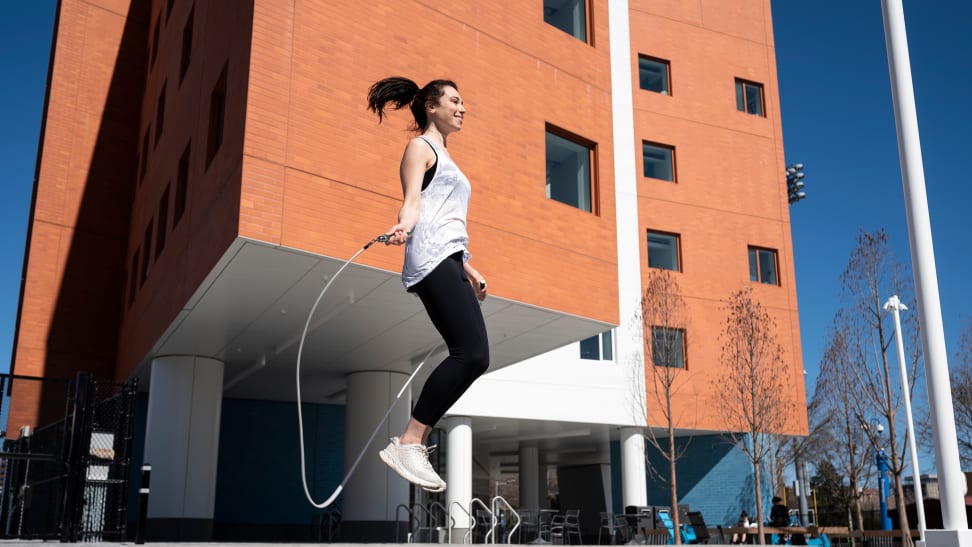 Credit:
Reviewed / Jackson Ruckar
Credit:
Reviewed / Jackson Ruckar
Products are chosen independently by our editors. Purchases made through our links may earn us a commission.
Like a lot of people, I spent a good portion of my childhood skipping rope. Solo jump rope, double dutch at recess, even an ankle-busting device called a Skip-It in my backyard—you name it, I’d, er, jump to use it.
Why I stopped, I can’t say for sure, though I suspect it has something to do with my decreasing need to burn off energy before nap time and my increasing need for a good sports bra to see me through the jumps ... but eventually, any jumping I did became relegated to when I was instructed to do so in cardio workout classes.
Recently, I got a chance to try Crossrope, a weighted jump rope for grown-ups that promises to deliver effective cardio and strength-training workouts and, in theory, lets you have fun at the same time. I tried several of Crossrope’s offerings, along with its Premium app, for two weeks—here’s what happened.
What is Crossrope?
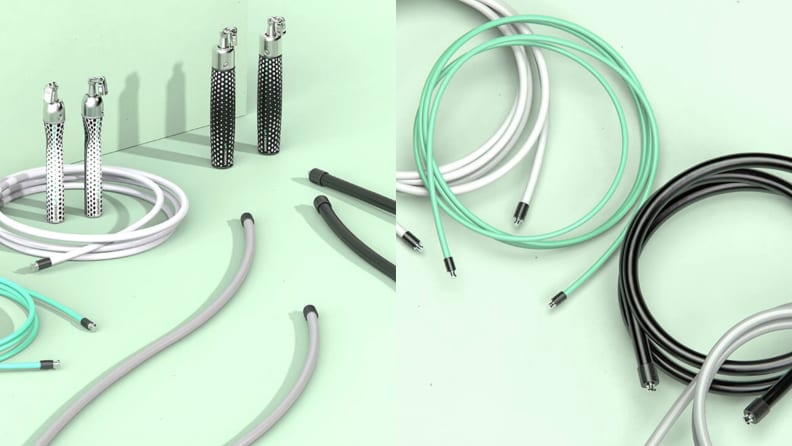
Crossrope sells weighted jump ropes that clip in and out of ergonomic handles.
Crossrope is a jump rope brand that sells weighted ropes ranging from a quarter pound to two pounds, which clip in and out of its ergonomic handles so you can increase or decrease as desired. The ropes are made of braided steel covered in rubber, which Crossrope says eliminates tangles and, of course, provides the stated heft. They differ from some other “weighted ropes” because most others add weights to the handles only, rather than the rope itself.
The ropes are sold in sets based around a fitness goal you may have. Your options include the “Get Lean” set, which includes one set of handles weighing about half a pound each and a quarter-pound and half-pound cable for $99, the “Get Strong” set, which includes a thicker, heavier set of handles (at about a pound each) and a one-pound and two-pound cable for $149. You can also get the “Get Fit” set, which includes both packages for $248 (curiously, at no discount than if you bought each individually), or you may buy the handles and ropes separately—say, if you just want the half-pound and one-pound ropes. (The site almost always has some kind of promo code that gets you a discount on its various packages.) You select your rope length based on your height, and options are suitable for users between 4 feet 9 inches and 6 feet 9 inches. You can also buy accessories to enhance your workouts, such as the $99 Jump Mat, a thick, oval-shaped mat that helps absorb shock from jumps to protect the joints and muffle noise and other specialty speed ropes and apparel. Crossrope sent me its Get Fit bundle, plus the mat to try out.
When you purchase any Crossrope set, you can also add on a 30-day trial of its Premium app, which includes more than 200 workouts, tutorial videos for different kinds of jumps, and fitness challenges that “stack” different workouts. After the 30-day trial, it’s $9.99 a month or $79.99 a year. Crossrope also offers a free “Lite” app, which includes only the jump tutorials, some challenges, and 10 workouts. New workouts are added every weekday, so if you use the Lite app sporadically, it’s hard to run out of workouts.
What are the benefits of using a weighted jump rope?
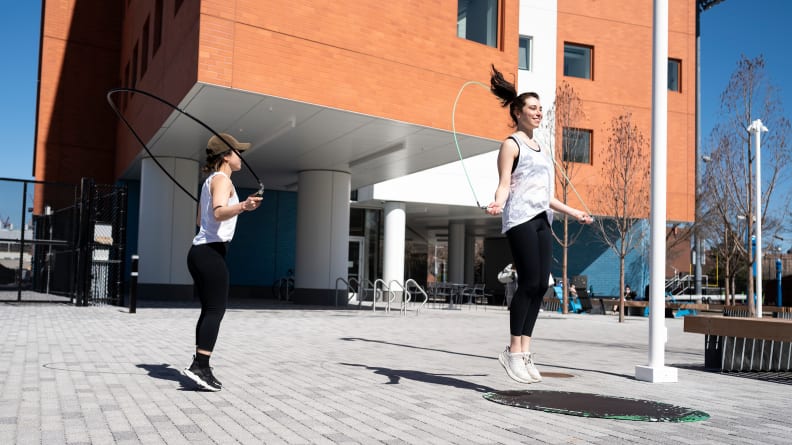
Weight helps make jumping rope an even better workout.
Jumping rope, in general, is a fantastic workout. “The cool thing about jumping rope is that it’s really just a great mode of cardio exercise, so you get the benefits with improved heart health, mental health, even cognitive benefits,” says Chris Gagliardi, scientific education content manager at American Council on Exercise (ACE). Jumping rope also works the whole body. In addition to the cardiovascular benefits, it engages the muscles of the legs, core, and arms and may increase bone density from the impact of landing over and over.
When I started jumping, I was surprised by how much it took out of me. I’m a pretty fit person—I run, I do yoga, I do HIIT—but simply jumping in place with the light quarter-pound rope, which is hardly heavier than a standard jump rope, required more energy than I remembered—and got me sweating fast. When I leveled up to the two-pound rope, which looks and feels like a slim garden hose, I could feel my arms, core, and legs being challenged much more.
For this reason, you’ll want to make sure you master your jumping form before you make it a serious part of your workout. A key part of skipping success, according to Gagliardi, is ensuring the rope is the correct size for your frame. If you aren’t able to get a rope sized, step on the middle of the cord and pull up the handles. If the bottom part of the handles reach your armpits, you’re good.
Jumping rope should be an intuitive movement, but it’s vital to take care to stand up straight, keep your shoulders back and loose, and your arms close to your body as you jump. “One key thing is using your wrists and minimizing movement in other key parts of your body, like the shoulders and the elbows, so you’re generating the movement of the rope through wrist action,” says Gagliardi. If possible, place yourself in front of a mirror so you can make corrections as you move.
When you’re just starting out, a weighted rope may be easier than a lighter one—it moves slower so it’s easier to keep track of, according to Gagliardi—but it’s more strenuous on your body, so if you aren’t jumping with correct form, it could take a toll. “[There’s a possibility of injuring] rotator cuff, wrists, lower back if you’re just trying to muscle through the workout,” says Holly Rilinger, a Nike Master Trainer and creator of the workout program Lifted. “A good rule of thumb is [to ask yourself], ‘Am I breaking my form to handle this much weight?' So if suddenly you find yourself jumping differently because that weight’s been added, you need to back off and just spend a little more time mastering that skill with a lesser weight.”
What I like about Crossrope
Crossrope’s materials are high quality and easy to use
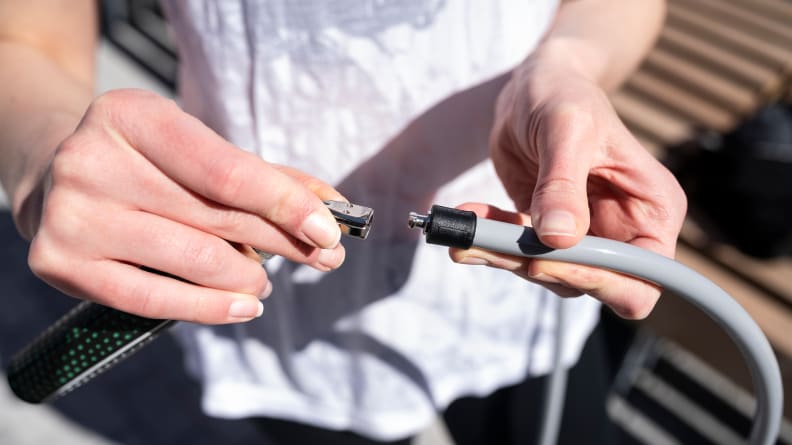
Crossrope's handles clip in and out easily.
First, the basics: The device itself is top quality. (Which, at $248 for a set of four, I’d expect.) The jump rope works well as a whole, but for me, Crossrope’s handles are what make it feel extra luxurious. Most jump ropes I’ve used have foam handles, which are fine at first but tend to get slippery during long workouts and degrade over time. Crossrope’s slim handles (for the lighter ropes) and power handles (for the heavier ropes) are made of a silicone-like material, which is soft to the touch but not as prone to flaking as regular foam, and curved and grooved in such a way that makes for a sure grip, even during long, sweaty jumping sessions. They differ in shape, with the slim ones being, well, slimmer, but both fit fine in my hands. Both handles have steel bearings, which helped the ropes swing around smoothly and feel secure as I was jumping.
The handles make it easy to switch the ropes in and out, too. All I had to do was hold down two clips on the handle, gently tug on the cable I wanted to remove, and slide the other rope into the handle until it clicked into place. When I took jumping clases on the app, it usually gave me about a minute to switch the ropes, but I always finished in less than half the time (and gladly used my remaining 30 seconds to drink some water).
The ropes themselves are great, too, if a little less flashy. One thing I found especially impressive is that, true to Crossrope’s promise, they never tangled, even the thinner ones. I also felt a clear difference in the heavier ropes and the lighter ones—the lighter ones felt like standard jump ropes, but the heavier ones moved slower and forced me to engage my core and upper body isometrically so I could control the rope and my jumping cadence. I’m 5 feet 7 inches, so I used the medium-length rope, which is 8 feet 6 inches and intended for people between 5 feet 4.5 inches and 5 feet 9 inches. When you buy your Crossrope, you pick your length, and although this would make it difficult to share with someone who doesn’t fit into that exact range, I loved having it sized to my height. I felt more secure with my swings, knowing that the rope wouldn’t fly too high or short above or below my head and made me feel confident about trying out jumping tricks like criss-cross jumps or double unders that I’d never tried before, even in the jumping days of my youth.
Crossrope’s free app is surprisingly great
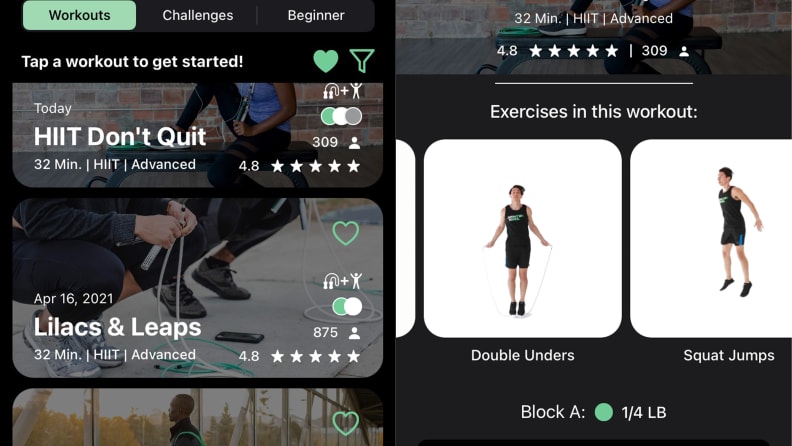
The Crossrope Lite app gives you access to the 10 most recent workouts.
Crossrope’s free edition of its app is also better than it has to be. You always have access to tutorial videos and 10 of the most recent Crossrope workouts (updated every weekday), which include strength-based workouts (intended for use with one- and two-pound ropes) and HIIT-based workouts (intended for use with the lighter ropes) aimed at “beginner” and “advanced” levels. It’s clear which is which, and you can preview what you’re going to do in the workouts. This makes it easy to figure out how to best use your ropes and turns it from what could be a tool used intermittently into a cohesive workout routine. The workouts on the free version of the app update every weekday, so if you prefer to use the Crossrope itself as a supplement to your other workouts and do the app workouts once or twice a week, you may never run out of fresh content.
Also, the app workouts don’t just involve jumping (something that provided me with some relief, anyway). Instead, jumps like the basic jump, freestyle jump, and (in advanced workouts) criss-cross and double-under jumps are interspersed with bodyweight exercises like squats, push-ups, and planks. The workouts aren’t the most stylistically engaging—the instruction comes from an audio voiceover and the exercises are demonstrated in still photos that you scroll through like a slideshow—but it delivers an effective workout. The app also does not play any music, but you can also play your own from a streaming service or your music library on the same device and it doesn’t interfere with the audio. Because the workouts are always the same as what Premium has to offer (just in a lesser quantity), it’s a better free trial than most.
The ropes are versatile and easy to pack up

The ropes are very packable.
Finally: The ropes are very easy to store. Sure, this is more of a benefit of jump ropes in general than Crossrope specifically, but it’s worth pointing out with this set, especially considering the footprint of other cardio equipment like treadmills and exercise bikes. Crossrope’s cables come with a little nylon drawstring pouch, too, so it was simple for me to pack them away when I was done using them. I tested them at Reviewed’s office, where I have more space than at my apartment, but I could stow them under my bed with ease (and, one day, pack them in a suitcase for a vacation).
What I don’t like about Crossrope
The paid version of the app isn’t up to snuff
My Crossrope complaints are pretty minimal. That said, I had some issues with the paid version of the app. As much as I loved the free version, Premium had enough small but annoying problems that made me question whether it would be worth the upgrade cost of $10 a month. For one thing, the Crossrope workouts play directly on the app (like pretty much any other workout app but its tutorial videos link out to YouTube no matter whether you use the premium or free version. This isn’t a huge deal, but having to view videos in a different window made it feel a little disjointed and diminished my overall experience with the app. This also meant that I felt a little lost during workouts, especially as I was getting started. I saw the video of different kinds of jumps on the screen, but it was hard to tell exactly what to do for more complicated ones—or ones that look very similar on the app's display, like ski jumps and boxer steps—without closing out of the workout.
I also would have liked to have an “intermediate” workout section, as the beginner workouts got easy quickly, but my criss-cross jump never got to the level that I felt all that confident with the advanced classes. The app doesn’t offer any modifications to the exercises it calls out, so, though you can modify them yourself (say, by choosing to do a basic jump instead of a criss-cross), you’re on your own if the app calls for exercises beyond your abilities.
The app also only has classes that involve jumping rope (not, say, yoga), so you can’t get as much workout variety as you do with other apps that cost the same, like Apple Fitness+. All in all, there’s a lot to gain from having access to more than 200 Crossrope-specific workouts—but if I were to use Crossrope going forward, I’d try to max out the free app and whatever resources I could find on YouTube before paying for the app.
Jumping rope itself has some pitfalls
I also had some issues with the ropes that, though not specific to Crossrope, are worth pointing out. The first is that jumping mistakes tend to be painful. I had a few instances with the lighter rope whipping out of my control and smacking my calves. The heavier weights move slower, and are thus easier to control, but I imagine getting whacked on the ankle with a two-pounder would not feel very good.
You also need a decent amount of space above your head to use any jump rope—so, while Crossrope is ideal for storage, you need to consider where you’re going to use it. If you live in a space with relatively low ceilings, you’ll need to get creative with where you go to jump—if you have access to a gym, garage, or any outdoor space, you’ll be fine.
Is Crossrope worth it?

Crossrope's high-quality handles and cables make it worth it to me.
One potential point of contention with Crossrope is the cost. You can buy other weighted ropes on Amazon for much less money ($12.99 for one top-rated option). I haven’t tried these other ropes, so I can’t vouch for or doubt them one way or another—but I can say that Crossrope’s jump ropes are high quality enough to be worth it if you actually use them. Most of the other weighted jump ropes I looked at have weights in the handles (rather than the rope), don’t let you switch out the cables, require you to size them yourself by measuring and shortening the rope, and have those foam handles that tend to degrade over time. If you’re not sure how much you’ll use your jump ropes, it may be worth trying out a cheaper version with some Crossrope classes on YouTube to see how you like it as an exercise in general before ponying up the cash.
Should you get Crossrope?
I love Crossrope and think the whole “Get Fit” set is worth it. But if you’re deciding between the “Get Lean” or “Get Strong” bundle, I’d go with the heavier “Get Strong” version—the lighter ropes should be easier to replicate with a cheaper set, but the heavy weights feel unique to Crossrope.
No matter what you choose, if you know you’re going to do a lot of jumping, and want to add some challenge to it, Crossrope will see you through.
